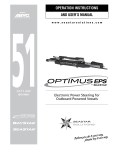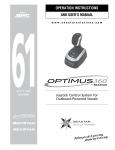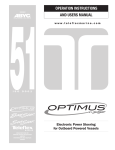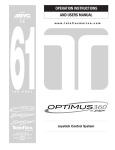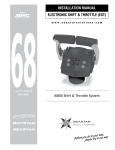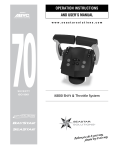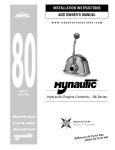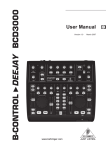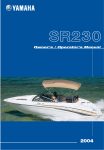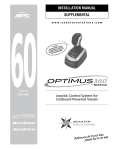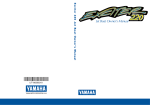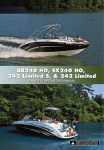Download operation instructions and user`s manual
Transcript
OPERATION INSTRUCTIONS 62 SIXTY TWO ISO 9001 AND USER'S MANUAL www.seastarsolutions.com Joystick Control System for Engines with Integrated Electronic Shift and Throttle way, r u o y it o d Before yopulease try it our way ©2013 SeaStar Solutions. All Rights Reserved. This document, subject matter and all information herein is the sole, exclusive and confidential property of SeaStar Solutions and shall not be disclosed, copied, reproduced or used in whole or in part for any purpose other than as specifically authorized in writing by Marine Canada Acquisition (DBA SEASTAR SOLUTIONS). All information, illustrations and specifications in this manual are based on the latest information available at the time of publishing. The illustrations used in this manual are intended as representative reference views only. Moreover, because of our continuous product improvement policy, we may modify information, illustrations and/or specifications to explain and/or exemplify a product, service or maintenance improvement. We reserve the right to make any change at any time without notice. is a registered trademark of the American Boat & Yacht Council (http://www.abycinc.org) NMEA 2000 is a registered trademark of the National Marine Electronics Association. ® Optimus, Optimus 360, SeaStar, and BayStar are all trademarks of SeaStar Solutions. Evinrude, Suzuki, Yamaha, and Yanmar are trademarks of their respective holders. California Proposition 65 Warning Battery posts, terminals, and related accessories contain lead and lead compounds, chemicals known to the state of California to cause cancer and reproductive ham. Wash hands after handling. Thank you for choosing an OptimusTM 360 Joystick Control System by SeaStar Solutions. You have chosen a state of the art vessel control system that will provide years of effortless and trouble free steering performance. About this Book This User’s manual contains the information you need to safely operate and maintain your vessel control system. It must remain on the boat. Notice to the Operator Throughout this publication, Dangers, Warnings and Cautions (accompanied by the International Hazard Symbol ) are used to alert the user to special instructions concerning a particular service or operation that may be hazardous if ignored or performed incorrectly or carelessly. Observe them carefully! These safety alerts alone cannot eliminate the hazards that they signal. Strict compliance with these special instructions during installation, operation, and maintenance, plus common sense operation, are important measures to prevent accidents. Failure to adhere to these notices may result in the loss of steering and shift/throttle control, leading to possible ejection from the vessel, causing property damage, injury and/or death. DANGER Immediate hazards which, if not acted upon, WILL result in severe personal injury or death. WARNING Hazards or unsafe practices which, if not acted upon, COULD result in severe personal injury or death. CAUTION Hazards or unsafe practices which could result in minor injury or product or property damage. notice © 2013 SeaStar Solutions Information which is important to proper use or maintenance, but is not hazard-related. Optimus 360 Joystick Control System, Rev. D i This page left intentionally blank. ii © 2013 SeaStar Solutions Optimus 360 Joystick Control System, Rev. D INDEX 1.0 Safety Instructions............................................................. Safety Labels.................................................................... Abbreviations.................................................................... Definitions........................................................................ 1-1 1-3 1-6 1-7 2.0 Introduction....................................................................... 2.1Welcome.................................................................. 2.2 Optimus 360 System Overview.................................. 2.3 Optimus 360 System Diagram................................... 2-1 2-1 2-1 2-3 3.0 Component Identification.................................................... 3.1 Electronic Helm(s) (EPS System)................................ 3.2 Control Head (EST System)........................................ 3.3Joystick.................................................................... 3.4 CANtrak Display........................................................ 3.5 Circuit Breakers for Optimus 360 System................... 3.6 Pump Control Module (PCM)...................................... 3.7 Hydraulic Pumps....................................................... 3.8SmartCylinders......................................................... 3.9 Steering Service Valves............................................. 3-1 3-1 3-2 3-3 3-4 3-4 3-5 3-5 3-6 3-6 4.0 Steering System Operation................................................ 4-1 5.0 Control Head Operation....................................................... 5-1 © 2013 SeaStar Solutions 6.0 Joystick Operation.............................................................. 6.1 Joystick Fundamentals.............................................. 6.2 Joystick Tips............................................................. 6.3 Joystick Operation Examples...................................... 6-1 6-2 6-5 6-6 7.0 CANtrak Display ................................................................ 7.1Purpose................................................................... 7.2 CANtrak Display Navigation........................................ 7.3 CANtrak Display Map – All Helms Active...................... 7.4 Display Screens........................................................ 7.4.1 All Helms Active............................................... 7.4.2 Adjust (ADJ) Screen.......................................... 7.4.3 Display (DISP) Screen...................................... 7-1 7-1 7-2 7-3 7-4 7-4 7-5 7-7 8.0 First Time Use.................................................................... 8.1 Control Head Adjustments......................................... 8.2 Initial Start Up.......................................................... 8.3 System Inspection.................................................... 8.4 Installation Checks................................................... 8.5 Initial Sea Trial.......................................................... 8-1 8-1 8-2 8-4 8-6 8-7 Optimus 360 Joystick Control System, Rev. D iii 9.0 System Use........................................................................ 9.1 Before Each Use....................................................... 9.2 Multiple Station Boats............................................... 9.3 Autopilot Operation................................................... 9-1 9-1 9-1 9-2 10.0 System Faults & Hazards................................................ 10-1 10.1 Hazard Definitions................................................... 10-1 10.1.1 Danger........................................................ 10-1 10.1.2 Warning....................................................... 10-2 10.1.3 Caution........................................................10-2 10.2 System Fault Handling............................................. 10-3 10.2.1 Danger Fault Handling.................................. 10-3 10.2.2 Limp Home.................................................. 10-4 10.2.3 Warning Fault Handling................................. 10-6 10.2.4 System Fault Handling – Example.................. 10-8 10.2.5 CANtrak Loss of Display............................... 10-9 10.3 Buzzer.................................................................. 10-10 10.4 Reduced Performance........................................... 10-10 11.0 Maintenance.................................................................. 11-1 12.0 Troubleshooting.............................................................. 12-1 13.0 Replacement Parts......................................................... 12-2 13.1SeaStar Electronic Power Steering Fluid.................... 12-2 14. Warranty.......................................................................... 14-1 14.1Statement of Limited Warranty................................. 14-1 14.2Return Goods Procedure ........................................ 14-1 APPENDIX A - Specifications................................................... 14-2 APPENDIX B - Trailering and Storage........................................ B-1 iv © 2013 SeaStar Solutions Optimus 360 Joystick Control System, Rev. D 1.0 Safety information WARNING WARNING The safety information provided below is intended to inform you of the dangers that may be present before, during and after use. It is critical that you read and understand ALL the points noted. The Optimus 360 System MUST ONLY be installed by an authorized dealer or OEM. Safe operation of the steering system depends upon proper installation and maintenance of the system, and the common sense, safe judgment, knowledge, and expertise of the operator. Every installer and operator of the steering system should know the following requirements before installing or operating the steering system. If you have any questions regarding any of these warnings, contact SeaStar Solutions. To reduce the risk of severe injury or death: 1. Always wear a Coast Guard Approved personal flotation device (PFD) and use an engine shut-off cord (lanyard). 2. Read and understand this User’s manual and the Quick Reference Card provided with your vessel control components. 3. SeaStar and Optimus components are highly engineered and safety tested to ensure system integrity. DO NOT substitute any component. Substitution with non-SeaStar or non-Optimus components may compromise system safety, performance, and reliability. Prior to every use Perform a system inspection as outlined below. Refer to Section 8.3 for further details. 1. Check steering fluid level in all steering pumps. 2. Verify immediate steering response when turning steering wheel(s). 3. Inspect all steering hoses, fittings and mechanical and electrical cables for wear, kinks, or leaks. 4. Check for binding, loose, worn or leaking steering or shift/throttle control components. 5. Verify proper shift and throttle response for all control levers. 6. Verify that no alarms or warnings are shown on the CANtrak display. WARNING © 2013 SeaStar Solutions Do not operate boat if any component is not in proper working condition. Optimus 360 Joystick Control System, Rev. D 1-1 1.0 Safety information (continued) During use WARNING After use 1.wear a coast guard-approved personal flotation device (PFD). 2. Attach engine shut-off cord (lanyard) to your pfd. 3. Never allow anyone not familiar with the operation of the vessel control system to operate the boat at ANY time. 4. Know and adhere to all applicable federal, state, and municipal laws and regulations that govern boating in your area. do not operate boat if any component is not in proper working condition. Rinse off the SmartCylinders thoroughly, using only fresh, clean water. DO NOT rinse the PCM, pumps, actuators, or any other component of the Optimus system. DO NOT use cleaners containing ammonia, acids, or any other corrosive ingredients on any Optimus components. Maintenance Maintain your Optimus 360 System as directed in Section 11 of this manual. Keep our waters clean for all current and future users. Dispose of all fluids in accordance with your local regulations. 1-2 © 2013 SeaStar Solutions Optimus 360 Joystick Control System, Rev. D Safety Labels WARNING NOTE: The labels below should call attention to the possible hazards associated with the equipment shown later in this manual (see Section 3.1) Hydraulic Pump Labels WARNING DO NOT OPEN VALVE WITH ENGINE(S) RUNNING HYDRAULIC STEERING PUMP PART No. EP1500 6.9 MPa (1000psi) MAX. 12 Volt STEERING SERVICE VALVE SERIAL NO: 12-100001 WARNING Refer to User's Manual for use of valve. Prior to use check fluid level in pump reservoirs. Install and maintain in accordance with SeaStar Solutions installation manuals. Use SeaStar Electronic Power Steering Fluid ONLY. NEVER use brake fluid. Any non-approved fluid may cause irreparable damage resulting in loss of steering control and may void warranty. Failure to comply with the above warnings may result in loss of steering control, leading to possible ejection from vessel causing property damage, personal injury and/or death. SEASTAR SOLUTIONS RICHMOND, BC, CANADA 682130 SAE J-1171 OPERATION: • TURN OFF ENGINES • FULLY TURN KNOB COUNTERCLOCKWISE TO OPEN • MANUALLY MOVE ENGINE(S) TO REPOSITION • FULLY TURN KNOB CLOCKWISE TO CLOSE CAUTION HOT Figure 1-1. Hydraulic pump labels. © 2013 SeaStar Solutions Optimus 360 Joystick Control System, Rev. D 1-3 Safety Labels (continued) Pump Control Module (PCM) Labels Figure 1-2. PCM labels. SmartCylinder Labels Figure 1-3. SmartCylinder labels. 1-4 © 2013 SeaStar Solutions Optimus 360 Joystick Control System, Rev. D Safety Labels (continued) Steering Service Valve Labels To be installed close to the service valve. Figure 1-4. Steering service valve labels. © 2013 SeaStar Solutions Optimus 360 Joystick Control System, Rev. D 1-5 Abbreviations The following abbreviations are used in this manual: ABYC American Boat & Yacht Council APAutopilot AUXAuxiliary AWG American Wire Gauge BATBattery CAN Controller Area Network CAN Bus Controller Area Network (data) Bus. (A cable of wires that carry digital signals and power between electronic modules) ECU Electronic Control Unit EIM Engine Interface Module ENGEngine EPS Electronic Power Steering EST Electronic Shift and Throttle FForward GNDGround GPS Global Positioning System HIHigh INFOInformation KHzKilohertz Km/h Kilometers Per Hour LED Light Emitting Diode LoLow mA or mAmp Milliamp (1/1000 of an ampere) MAGMagnetic MPH Miles Per Hour NNeutral NMEA National Maritime Electronics Association NMEA 2000® The special protocol for digital communication on a CAN Bus Nm Nautical Miles NSP Neutral Start Protection N/C No Connection PCM Pump Control Module PGN Parameter Group Number PSI Pounds Per Square Inch Power Train Sync PTS RReverse RPM Revolutions Per Minute SOG Speed Over Ground Speed Over Water SOW STBD Starboard (right when facing the front of the boat) SWSwitch Wide Open Throttle WOT Note: Some abbreviations not listed here may be found in their respective sections. 1-6 © 2013 SeaStar Solutions Optimus 360 Joystick Control System, Rev. D definitions © 2013 SeaStar Solutions Conventional Steering Control This is the standard type of steering that has been used on boats for many years. The steering wheel is the only means of control. Conventional Shift and Throttle The type of shift and throttle control where standard control head levers allows the engine gear selection and throttle control. Joystick Control A single handle joystick control device that integrates the steering, the gear shift, and the throttle control for multiple engines into one easy-to-use device to provide docking control of the vessel. Optimus 360 Joystick Control System, Rev. D 1-7 This page left intentionally blank. 1-8 © 2013 SeaStar Solutions Optimus 360 Joystick Control System, Rev. D 2.0 Introduction 2.1 Welcome Welcome to the world of electronic joystick control. Please take a few minutes to familiarize yourself with the System Overview and the First Time Operation sections. An understanding of the system will assure your safety and help you get the most enjoyment from your Optimus 360 joystick control system. 2.2 Optimus 360 System Overview An Optimus 360 system consists of: a)An Electronic Power Steering (EPS) system to provide effortless conventional steering. b)An engine manufacturer supplied electronic shift and throttle (EST) control system to provide ease of shift and throttle operation and various convenience features. c)An Electronic Joystick control system that can combine the EPS and the EST systems to provide complete boat control using a single intuitive interface. d)An electronic display to provide system status, faults, & instructions. The EPS system consists of an electronic helm located behind the steering wheel that is electrically connected to a pump control module (PCM). The PCM converts the steering wheel action to electrical signals that operate hydraulic pumps. These pumps move the smart steering cylinders (SmartCylinders) at each engine. The SmartCylinders are equipped with position sensors that feed engine position back to the PCM. Service valves are built into the steering pumps and allow for manual positioning of the engines should a fault occur, or for use by the technician during servicing. The engine manufacturer supplied EST system has a control head at each helm station to control the gear selection and operate the throttle. The control head sends electronic signals to actuators that actuate the shift and throttle. The Joystick Control system consists of a Joystick which interfaces to the EPS and EST system and, when activated, controls the overall motion of the boat with one easy-to-use device. A CANtrak display shows system operation and fault warnings. The CANtrak display also permits system sensitivity and configuration adjustments. The Optimus 360 system is designed and tested to exceed ABYC safety standards, and includes many advancements to make the system as fail-safe as possible. These include redundant sensors, fault-tolerant communications, self-monitoring, and fault communications to notify and advise the operator in case of fault. © 2013 SeaStar Solutions Optimus 360 Joystick Control System, Rev. D 2-1 2.3 Optimus 360 System Diagram COLOR CANtrak ENGINE GATEWAY 12 VOLT POWER BUZZER NMEA2000 CAN3 NETWORK HELM CAN1 NETWORK SERVICE PORT AUTOPILOT CCU CAN2 NETWORK POWER STEERING PUMP POWER STEERING PUMP RED BL A CK PCM BREAKERS GREY PURPLE PORT POWER SOURCE STARBOARD POWER SOURCE P S OFF COMPONENTS NOT SUPPLIED BY SEASTAR SOLUTIONS SWITCH PANEL HYDRAULIC HOSE SMART CYLINDER RUN HYDRAULIC HOSE SMART CYLINDER Figure 2-1. Optimus 360 system diagram, single station. 2-2 © 2013 SeaStar Solutions Optimus 360 Joystick Control System, Rev. D 3.0 component Identification 3.1 Electronic Helm(s) (EPS System) The electronic helm is the primary user interface for conventional steering control. When in conventional steering control, all helms on the boat are active and can steer the boat. The steering wheel is attached to the helm, which may be located immediately under the wheel or just behind the dash panel. The images below show typical helms. Refer to Section 4.0 for steering operation. CAUTION Keep magnets away from the helm. they may interfere with proper helm operation. EPS Front Mount Helm EPS Sport Plus Tilt Helm EPS Classic Tilt Helm EPS Rear Mount Helm Figure 3-1. EPS Helm configurations. © 2013 SeaStar Solutions Optimus 360 Joystick Control System, Rev. D 3-1 3.2 Control Head (EST System) The control head is the primary user interface for conventional shift and throttle control. The control head operates the gear shift and the throttle for each engine. For detailed control head operation, refer to your engine manufacturer’s installation manual. Figure 3-2. Example Control Head shown. 3-2 © 2013 SeaStar Solutions Optimus 360 Joystick Control System, Rev. D 3.3 Joystick The joystick is the primary user interface for joystick control. The joystick interfaces with the steering system and with the shift and throttle system. It integrates the two systems together so as to have complete boat control that is very intuitive from a single device. The joystick can only take control of the vessel when the shift and throttle control head is at neutral idle. See Section 6.0 for detailed Joystick operation. Figure 3-3. Joystick. © 2013 SeaStar Solutions Optimus 360 Joystick Control System, Rev. D 3-3 3.4 Cantrak Display There is a display at each helm station that shows the system status and allows system adjustments. See Section 7.0 for CANtrak usage. Figure 3-4. CANtrak display. 3.5 Circuit Breakers for Optimus 360System These are supplied by the installer and may be mounted in a variety of locations. Check near the batteries, in the circuit breaker box, or near the pump control modules or hydraulic pumps. There should be two 60 amp breakers for each PCM. 3-4 © 2013 SeaStar Solutions Optimus 360 Joystick Control System, Rev. D 3.6 Pump Control Module (PCM) This is located in a dry area and can usually be found inside the center console, in the area behind the dash, or in a compartment near the engines or batteries. The PCM is always located close to the hydraulic pumps. There will be one PCM on twin engine boats and two PCM’s on triple or quad engine boats. The PCM controls the steering and joystick operation. Figure 3-5. PCM. 3.7 Hydraulic Steering Pumps The hydraulic steering pumps supply pressurized fluid to the SmartCylinders to steer the engines, and are located near the PCM. They can usually be found in a compartment near the engines, the center console, or behind the dash. There is one pump for each steering cylinder. The steering fluid reservoir is mounted directly to the pump; it is here that you will check the fluid level and add steering fluid as necessary. STEERING SERVICE VALVE Note: these pumps look similar to the trim pumps that tilt the engines. They can be distinguished by the integrated steering service valve. Figure 3-6. Hydraulic steering pump. © 2013 SeaStar Solutions Optimus 360 Joystick Control System, Rev. D 3-5 3.8 SmartCylinders On outboard boats these are always located just below the engine cowling and are attached to the engine tiller arm. There will be one SmartCylinder for each engine on twin-engine boats. Most triple- and quad-engine boats use tie-bars to steer a pair of engines with a single SmartCylinder. Figure 3-7. SmartCylinder with sensor. 3.9 Steering Service Valves WARNING Wear a coast guardapproved personal flotation device (PFD) when manually realigning engines. The steering service valves permit the bypass of the EPS system and allow the engines to be manually positioned. They should only be used in the event of an EPS system failure, in which case instructions will be given on the CANtrak. The service valves are integrated into the power steering pumps. To open the valve, turn the knob fully counter-clockwise until it stops (about three turns). Turn the knob fully clockwise to close it. Turn just until you feel the valve contact the stop – do not use tools or over-tighten. Some vessels may be fitted with remote service valves as shown in figure 3-8. OPEN (FULLY TURN COUNTER-CLOCKWISE) POWER STEERING PUMP SERVICE VALVE CLOSED (FULLY TURN CLOCKWISE) Figure 3-8 Remote steering service valve. 3-6 Figure 3-9. Service valve location. © 2013 SeaStar Solutions Optimus 360 Joystick Control System, Rev. D 4.0 Steering system Operation The steering portion of the Optimus 360 system provides fingertip steering control of multiple high-powered engines. The system provides both power and the adjustment of a number of parameters so the operator has perfect boat response under all conditions. The system will power on with the ignition switch and operate much like a conventional steering system except the feel will be extraordinary and the effort just perfect for the conditions, providing just the right amount of response and pressure. The CANtrak display will provide the status of the steering system and supply information in the event of a fault. On multiple helm station boats, all helms are active when the steering is on just like with conventional steering. The dealer that installs the system will make the necessary adjustments at the time of installation to achieve exceptional steering performance. The operator may further refine the feel using the CANtrak display. See Section 7.4.2. The quick reference steering guide provided with the system gives summary and reminder information about the steering system and should be kept at the primary helm station at all times. The system may be connected into an autopilot to further enhance the boating experience. See Section 9.3. © 2013 SeaStar Solutions Optimus 360 Joystick Control System, Rev. D 4-1 This page left intentionally blank. 4-2 © 2013 SeaStar Solutions Optimus 360 Joystick Control System, Rev. D 5.0Control Head Operation WARNING Be very cautious when first engaging the gears to establish that forward is truly forward and reverse is truly reverse. A quick in-and-out of gear test is recommended. Ensure that the boat is clear of all obstacles forward and aft before conducting this test. The Control Head The control head is the primary user interface for conventional shift and throttle controls. Please ensure you are familiar with the specific operation of your electronic shift and throttle (EST) system before use by consulting your engine manufacturer’s manual for detailed operation. WARNING Be very cautious when first engaging the gears. Your Optimus 360 joystick control system is designed to work with a variety of different EST systems provided by different engine manufacturers. Each engine manufacturer will have their own unique transfer routine to switch from joystick control back to conventional shift and throttle control. Refer to the table below for your specific transfer details. Always put the joystick in its neutral position before transferring control. Engine Manufacturer Transfer to control head Indication of transfer Evinrude Press + button on control head 1. Joystick blue lamp(s) turn OFF* 2. Control head lamp(s) turn ON Suzuki Press Select button on station control panel 1. Joystick blue lamp(s) turn OFF* 2. Select LED turns ON Yamaha To control head at active station: 1. Joystick blue lamp(s) turn OFF* Move the control head levers out of neutral OR Press Take Command on the active joystick to toggle control back to the control head. To control head at another station: 1. Control head lamp(s) turn ON Press Station Selector on the Yamaha panel. Yanmar – BY2 Engine Press Take Command button on control head 1. Joystick blue lamp(s) turn OFF* 2. Control head lamp(s) turn ON * A steady red lamp indicates transfer when the joystick is not operational due to a system fault. Table 5-1. Transfer Control back to Control Head. © 2013 SeaStar Solutions Optimus 360 Joystick Control System, Rev. D 5-1 This page left intentionally blank. 5-2 © 2013 SeaStar Solutions Optimus 360 Joystick Control System, Rev. D 6.0 Joystick Operation The joystick is the primary user interface for the Joystick Control System. It offers the ultimate control of the vessel for docking and maneuvering at slow speeds and is especially useful in confined or difficult circumstances. It is quite intuitive to use as the boat follows the actions of the handle. This section of the manual gives a detailed description of all of its capabilities and how to get the maximum benefit from this powerful feature. The Optimus 360 Joystick Quick Reference Guide, provided with the system, gives summary and reminder information on its operation and should be kept on the vessel at all times. The joystick is spring loaded so it always returns to its center position. When the joystick is active and in the center position, the engines are in neutral and the throttles are at idle. The joystick Take Command button will make the joystick active when it is pushed. The shift and throttle controls must be in neutral to engage the joystick. When the joystick is active, the Take Command light will be solid blue. Consult Section 5 for transferring control back to conventional shift and throttle . While the joystick is active, the turning resistance of the steering wheel will increase to remind the user that it is disengaged. The Boost button increases the engine RPM when pressed. It may be activated any time the joystick is active. Note: The A and C buttons are reserved for future use and not active at this time. NOTICE © 2013 SeaStar Solutions While the joystick is active the turning resistance of the steering wheel will increase to remind the user that it is disengaged. Optimus 360 Joystick Control System, Rev. D 6-1 6.1 Joystick Fundamentals Handle Motion The handle can be moved in any direction or rotated left or right. When released the joystick will always snap back to center and put the engine in neutral idle. Moving the handle away from center or rotating it will cause the engines to shift into the correct gear for the desired motion. Further handle motion in the same direction will apply throttle and provide more thrust in the chosen direction. The joystick is proportional and guided in each axis. Boost Button Increases the power the engines can apply and may be turned on or off at any time. It can be very handy when handling the boat in wind or current. The system will remember the boost mode status so if it is left on, it will be on again next time the joystick is activated. A blue LED on the Boost button will illuminate when in boost mode. Take Command Button Activates the joystick and allows the joystick to take control of the vessel. To take control with the joystick, press Take Command with both control head levers in the neutral position. Note: If your boat has Yamaha engines you can only take command with the joystick at an active control station. To transfer to joystick control at another station, you must first press the Yamaha Station Selector button to activate the control station. The LED on the Take Command button is used to indicate joystick status: Figure 6-1. LED State Joystick Status Off joystick is inactive Steady blue joystick has control of the vessel Slow flashing blue joystick is initializing rudder and EST system Alternating red and blue flashing joystick has control of the vessel, but there is an active non-critical warning fault* Fast flashing red joystick has a critical fault* and is awaiting transfer of control to a control head Steady red joystick has a critical fault* and is not available for operation * See section 10 for fault handling information. A and C Buttons Reserved for future use. Not active at this time. 6-2 © 2013 SeaStar Solutions Optimus 360 Joystick Control System, Rev. D 6.1 Joystick Fundamentals (continued) Operation Fundamentals The levers on the active control head must be in the neutral position before a joystick may take command of the system. 1. The joystick has three primary operational modes (see illustrations next page): a) Forward/Reverse – engaged by pushing the joystick directly fore/aft. Causes the boat to move directly fore and aft. In this mode, the boat can be steered by rotating the handle. Always engage the Forward/Reverse Mode by moving the handle directly fore/aft then rotating the handle to steer. Rotating the handle first then pushing fore/aft would enter Rotation Mode and apply a forward correction in rotation mode. b) Sideways – engaged by pushing the joystick directly to port or starboard. Causes the boat to move directly sideways. In this mode, the handle can then be moved fore/aft or rotated to correct the vessel’s heading or position. c) Rotation – engaged by twisting the joystick while it is at center position. Causes the boat to rotate on the spot. A fore/aft handle movement after engaging rotation mode will cause the boat to rotate but with a forward or reverse bias. Always engage Rotation Mode first then apply the desired correction. Pushing the handle fore/aft then twisting would cause the system to enter Forward/Reverse mode with a steering correction. 2. When released, the joystick always returns to the center position, which provides neutral-idle for engines. 3. The joystick is proportional and guided in each axis - the more the joystick is moved, the more throttle is applied. See the following pages for examples of each of the primary operational modes. WARNING © 2013 SeaStar Solutions In the event of an engine stall, ONLY the Forward/Reverse mode is available. Restart stalled engine or switch to conventional controls. Optimus 360 Joystick Control System, Rev. D 6-3 6.1 Joystick Fundamentals (continued) Primary Motion – Forward/Reverse correction – rotate to steer Figure 6-2. a) Primary Motion – sideways correction – rotate to bias HEADING Figure 6-3. NEUTRAL b) Primary Motion – sideways OR correction – Forward/Reverse to diagonal Reverse Figure 6-4. 6-4 NEUTRAL © 2013 SeaStar Solutions Optimus 360 Joystick Control System, Rev. D 6.1 Joystick Fundamentals (continued) Primary Motion - Rotation correction Forward/reverse to bias rotation Figure 6-5. c) 6.2 Joystick Tips 1. Plan out your joystick maneuvers before you approach your target: a. Keep it simple - Minimize diagonal and other complex maneuvers. This allows for better boat correction and control. b. Know your boat’s limitations – Be aware of wind and current, and understand the boat’s movement delay due to its momentum. Some conditions may prove too strong for your engine thrust. 2. Make it clear to the system what you want to do. Do not make slight movements off of the neutral position. For example: If you want the boat to move to port, move the joystick well along the port axis. 3. Moving the handle port/stbd will move the boat sideways, but will not steer the boat (change heading). Twisting (rotating) the handle steers and rotates the boat (see illustrations previous page). 4. It is recommended to return to the center position when switching between primary operational modes. 5. Practice joystick maneuvers in open water before attempting close quarters docking. This will help you understand the primary operational modes and how they control your boat. 6. There is a momentary shift delay built into the system when returning from any gear activity to neutral. This allows bumping the handle to get a little more motion in the same direction without causing excessive engine shifting. This delay is removed if the action passes the home area in the opposite direction so you can stop the boat immediately if needed. 7. The control head must be active at the helm station with the joystick that will be used and the control handles must be in neutral and idle at that station. © 2013 SeaStar Solutions Optimus 360 Joystick Control System, Rev. D 6-5 6.3 Joystick Operation Examples Example 1 Make the primary action move first and then adjust the boat motion with a secondary joystick motion. Example: the boat is parallel to the dock and you wish to move the boat against the dock. This is like parallel parking a car. 1. Move the boat forward or backward with direct forward or backward joystick motions until the boat is stopped and centered in the location on the dock you wish to approach. 2. Return the joystick to the center position. 1 2 Figure 6-6. Figure 6-7. 3. Move the joystick directly port to approach the dock. 3a. If the boat does not stay parallel due to wind or current while holding the joystick to the side just rotate the joystick to keep the boat parallel to the dock during the approach. 3b. If the boat does not stay centered due to wind or current while holding the joystick to the side, just push or pull the joystick fore/aft to correct. 4. Once close to the dock, return the joystick to the center position. 6-6 © 2013 SeaStar Solutions Optimus 360 Joystick Control System, Rev. D 6.3 Joystick Operation Examples (continued) 3 3a wind Figure 6-8. Figure 6-9. 3b 4 CURRENT Figure 6-10. © 2013 SeaStar Solutions Figure 6-11. Optimus 360 Joystick Control System, Rev. D 6-7 6.3 Joystick Operation Examples (continued) Second Example 1. Move the boat forward by pushing the joystick forward. 2. With the joystick forward and the boat moving forward rotate the joystick as needed to correct for wind or current. Return the joystick to the home position as you near the slip. 3. As the boat approaches the slip pull the joystick backwards to stop the boat in front of the slip. Return the joystick to the home position when the boat stops. 1 2 Figure 6-12. Figure 6-13. wind 3 6-8 Figure 6-14. © 2013 SeaStar Solutions Optimus 360 Joystick Control System, Rev. D 6.3 Joystick Operation Examples (continued) 4. Rotate the joystick to turn the boat and align it with the slip. Use a straight port or starboard move of the joystick if necessary to realign the boat. 5. Pull the joystick back to move the boat into the slip. 6. A short bump forward on the joystick will stop the boat in position. © 2013 SeaStar Solutions 4 Figure 6-15. 5 Figure 6-16. 6 Figure 6-17. Optimus 360 Joystick Control System, Rev. D 6-9 This page left intentionally blank. 6-10 © 2013 SeaStar Solutions Optimus 360 Joystick Control System, Rev. D 7.0CANtrak Display 7.1 Purpose The Optimus 360 CANtrak display has an easy to navigate menu system, adjustable backlighting for night use and includes a cover to protect it from the sun when not in use. Figure 7-1. CANtrak display, All Helms Active screen. The CANtrak display serves these purposes: 1.Displays the current system operating conditions. 2.Handles system faults1 by: a) Displays system warnings in case of a system fault. b) Sounds an audible alarm in case of a system fault. c) Instructs the operator what to do in case of a system fault. 3.Permits changes to the basic system settings. 4.Provides system and diagnostic information For details on CANtrak operation see Sections 7.2 through 7.4 of this manual. Engine manufacturer supplied shift and throttle faults may not be communicated on this device. Refer to engine manufacturer’s manuals for information. 1 © 2013 SeaStar Solutions Optimus 360 Joystick Control System, Rev. D 7-1 7.2 CANtrak Display Navigation The five buttons at the bottom of the unit are used to select various actions. The five boxes at the bottom of the display screen will indicate the legend for each button. These legends vary based on what is on the screen. Figure 7-2. Navigation buttons and legend. Word or Symbol Identifies a function or setting Moves the cursor up the screen to the next item. Moves the cursor down the screen to the next item. Enters the sub-menu at the cursor location. Reduces the setting of the selected item. Increases the setting of the selected item. OK Accepts a given statement or condition and advances to the next screen. Returns to previous menu. Save 7-2 Saves change and returns to previous menu. © 2013 SeaStar Solutions Optimus 360 Joystick Control System, Rev. D 7.3 CANTrak Display Map – All Helms Active (Normal Steering Mode) The following diagram shows the progression from the Splash Screen to the All Helms Active Screen, then illustrates the various choices available from the All Helms Active screen. Splash Screen 3 Sec interval info Initial Warning NEXT System Check 1 NEXT System Check 2 back OK System Check 3 back OK All Helms Active Display Adjust display brightness MENU Settings* – Set steering parameters such as number of turns and steering effort. Faults – View active faults. System Health – View the status of all devices on the network. Good Warning, but operational Failed ? Not found Device List – Access product information, such as part number and serial number, for each device on the network. * Menu may be deactivated. Contact your dealer. Figure 7-3. CANtrak display map. © 2013 SeaStar Solutions Optimus 360 Joystick Control System, Rev. D 7-3 7.4 Display Screens 7.4.1 All Helms Active (Normal Steering Mode) The All Helms Active Mode screen will be displayed under normal operating conditions after the startup warning has been acknowledged. The All Helms Active screen displays the current system operating conditions. It shows the engine RPM, gear position, and rudder angle. It also allows access to the Diagnostics, Adjustment and Display menu screens. Figure 7-4. All Helms Active screen. 7-4 © 2013 SeaStar Solutions Optimus 360 Joystick Control System, Rev. D 7.4.2 Adjust (ADJ) Screen* If your dealer has provided you with this menu option then the Adjust screen allows adjustment of system parameters which affect steering operation and feel. Specific details of each parameter are listed below. Changes made in the Adjust screen are saved to memory upon exiting the Adjust screen. You will be prompted to save changes before exiting as shown in the display. Pointer buttons Scroll Bar Figure 7-5. Adjust (ADJ) screen. Helm Turns at Low Speed Sets the number of turns (hard-over to hard-over) when the vessel is running at low speeds. The range is 3.5 to 8 Turns. Helm Turns at High Speed Sets the number of turns (hard-over to hard-over) when the vessel is running at high speeds. The range is 3.5 to 8 Turns. Helm Effort at Low Speed Sets the steering resistance when the vessel is running at low speeds. It is adjustable between 1 and 100. Helm Effort at High Speed Sets the steering resistance when the vessel is running at high speeds. It is adjustable between 1 and 100. Helm Effort in Auto-Pilot Sets the steering resistance when autopilot is engaged. To prevent accidental course corrections with the wheel this should be set slightly higher than the high speed effort. It is adjustable between 1 and 100. * May not be available on all installations. Contact your dealer/builder. © 2013 SeaStar Solutions Optimus 360 Joystick Control System, Rev. D 7-5 7.4.2 Adjust (ADJ) Screen (continued) The steering resistance and turns have both low speed and high speed settings. The low speed and high speed set points may be determined by various sources, for example: Engine RPM, Throttle position, etc. These are configured by your dealer and are not adjustable. The number of turns and steering resistance at these low and high speeds are user adjustable*. These settings will automatically increase smoothly between the low speed and high speed points as shown in figure 5-5. CAUTION Adjusting steering effort for steering turns can significantly impact boat handling. Proceed with caution after making any changes. Figure 7-6. Change of helm settings with speed. * May not be available on all installations. Contact your dealer. 7-6 © 2013 SeaStar Solutions Optimus 360 Joystick Control System, Rev. D 7.4.3 Display (DISP) Screen The Display screen allows adjustment of the brightness and contrast (on monochrome models only) of the CANtrak display. These should be adjusted to provide good daytime and night time visibility of the display. Figure 7-7. Display adjustment screen. © 2013 SeaStar Solutions Optimus 360 Joystick Control System, Rev. D 7-7 This page left intentionally blank. 7-8 © 2013 SeaStar Solutions Optimus 360 Joystick Control System, Rev. D 8.0 first time use 8.1 Control Head Adjustments Before starting the engines for the first time, take a moment to familiarize yourself with the shift and throttle controls. With the engines not running and the control system turned off, move the control levers over the full range until you are familiar with the feel. The detent pressure and lever drag may be user adjustable. Refer to the documentation provided with your control head. Figure 8-1. Control Head lever positions. © 2013 SeaStar Solutions Optimus 360 Joystick Control System, Rev. D 8-1 8.2 Initial Start Up Turning on the ignition switch will turn on the Optimus 360 system. The CANtrak display will turn on and steering will become active at all helms. After reading the initial warning screen press the INFO button and follow the prompts for a system inspection. Splash Screen 3 Sec interval Figure 8-2. CANtrak initial warning screen. info Initial Warning NEXT System Check 1 back OK NEXT System Check 2 System Check 3 back OK All Helms Active Figure 8-3. All Helms Active screen (normal steering mode). WARNING 8-2 On multiple helm station boats all steering helms are active when the Optimus 360 is turned on. This is the same you would find on a conventional hydraulic steering system. © 2013 SeaStar Solutions Optimus 360 Joystick Control System, Rev. D 8.2 Initial Start Up (continued) With the system powered up, activate the desired control head or joystick by using the Select functionality on the control head or by pressing the Take Command button on the joystick device. If a joystick is selected, the joystick Take Command light should illuminate solid blue. The joystick now has control of the system and is ready for use. Refer to Sections 4.0, 5.0 and 6.0 for detailed steering, control head and joystick operation. © 2013 SeaStar Solutions Optimus 360 Joystick Control System, Rev. D 8-3 8.3 System Inspection WARNING Failure to adhere to these warnings may result in loss of boat control, leading to possible ejection from vessel; causing property damage, personal injury and/or death. 1.Check steering fluid level in all steering pumps. Each Optimus 360 hydraulic pump has a steering fluid reservoir. Ensure the fluid level is between the MIN and MAX marks on the reservoir as shown in the figure below. Use only SeaStar Electronic Power Steering Fluid in the Optimus 360 System. Figure 8-4. Location of fluid level marks. 2. Verify immediate steering response when turning steering wheel(s). Turn the steering wheel slowly to port and to starboard and make sure the engines follow the commands. Watch that the hoses harnesses, and cables move freely without any snags or hang-ups. 3. Inspect all steering hoses, fittings and mechanical and electrical harness for wear, kinks, or leaks. Check all steering hoses and fittings between the pump, service valves and cylinders for any signs of leakage, kinking, wear or chafing. Check all electrical harnesses and mechanical cabling for abrasion, wear, rubbing or chafing. Check that all connections are tight and free of corrosion. 8-4 © 2013 SeaStar Solutions Optimus 360 Joystick Control System, Rev. D 8.3 System Inspection (continued) 4.Check for binding, loose, worn or leaking steering or shift/ throttle control components. Check all shift and throttle components and harnesses for signs of wear, damage or chafing. Check that all linkages and cables move freely and are not binding or corroded. 5.Verify proper shift and throttle response for all control levers. Check that all shift and throttle levers operate freely and cause the engines to shift accordingly. Put the engines in neutral idle mode and confirm that the throttle responds correctly and returns to idle. 6.Verify that no faults or warnings are shown on the CANtrak display or the Shift and Throttle Control Head. If warnings are found on the CANtrak display, follow the instructions on the CANtrak screen or refer to Section 10 before proceeding. WARNING Read the System Inspection steps on the CANtrak display and acknowledge them by pressing the right hand most button under OK. Do not operate the boat if any component is not in proper working condition. After becoming familiar with the system inspection process, the operator can use the OK button to acknowledge that the system inspection process was understood and completed and can then go directly to the steering mode screen. WARNING © 2013 SeaStar Solutions It is recommended the full system inspection be reviewed on a regular basis to retain familiarity. Optimus 360 Joystick Control System, Rev. D 8-5 8.4 Installation Checks To verify correct installation of the Optimus SmartCylinder, perform the following installation checks when the boat is delivered and after each boat servicing. You will need someone to assist you. WARNING Failure to perform these checks may result in damage to the SmartCylinder sensor and affect the safe operation of the boat’s steering. 1. Interference Checks – Confirm that there is no interference between the steering cylinder(s), splashwell, outboard engine, or any combination of these parts, by performing the steps below. For each step also check that the hoses and cables are moving freely with no rubbing or binding (see figure 8-5 and figure 8-6). Be sure to steer slowly while performing these checks. a)With the engines fully tilted DOWN, turn the steering wheel from hard over to hard over and confirm that no interference occurs. b) With the engines fully tilted UP, turn the steering wheel from hard over to hard over and confirm that no interference occurs. c) Trim the port engine fully down and the starboard engine fully up. Turn the steering wheel from hard over to hard over and confirm that no interference occurs. d) Trim the starboard engine fully down and the port engine fully up. Turn the steering wheel from hard over to hard over and confirm that no interference occurs. WARNING If any issues are found during the installation checks, immediately return the boat to the service dealer for those issues to be remedied. ENGINE MOUNTING BRACKET ENGINE TRANSOM SMART CYLINDER CHECK FOR CLEARANCE TO BOTTOM SIDE OF SMART CYLINDER WITH ENGINE FULLY TILTED THROUGHOUT STEERNG RANGE Figure 8-5. Engine side view when tilted. 2.Sensor cable – Confirm that the SmartCylinder Sensor Cable is tied securely to the hoses with gradual bends as shown figure 8-6. 8-6 © 2013 SeaStar Solutions Optimus 360 Joystick Control System, Rev. D PORT EXIT CABLE (ALTERNATE METHOD) 6" MAX STARBOARD EXIT CABLE (PREFERRED METHOD) 6" MAX 6" MAX SMOOTH BEND (NO KINKING) TIE SECURED TO FITTING 6" MAX 6" MAX Figure 8-6. Sensor cable and hose routing checks. 8.5 Initial Sea Trial With the engine lanyard properly connected to you, and any passengers securely seated, carefully proceed to a section of deep, open water at a slow to moderate speed. Use the trip to get a feel for the steering and control response. When in open water that is deep enough to assure you will not run aground, try various maneuvers with the boat at various speeds until you are comfortable operating the boat. CAUTION Keep magnets away from the helm. They may interfere with proper helm operation. © 2013 SeaStar Solutions Be sure to spend some time becoming comfortable with each of the following: Steering – Check at various speeds and different rate turns. Joystick – Try all the various modes and using both primary and secondary actions. If adjustments to the system are required see Section 7.4.2 for steering adjustments or contact your dealer. Optimus 360 Joystick Control System, Rev. D 8-7 This page left intentionally blank. 8-8 © 2013 SeaStar Solutions Optimus 360 Joystick Control System, Rev. D 9.0system use If this is the first-time use, or for more details, see Section 8 of this manual. For detailed system operation see Sections 4 through 7. 9.1 Before Each Use WARNING Prior to every use: Perform a system inspection as outlined below, see Section 8.3 for further details. 1. Remove steering lock clips (see Appendix B) if they have been installed for trailering or storage. 2. Check steering fluid level in all steering pumps. 3. Verify immediate steering response when turning steering wheel(s). 4. Inspect all steering hoses, fittings, mechanical cables and electrical harnesses for wear, kinks, or leaks. 5. Check for binding, loose, worn or leaking steering or shift/throttle control components. 6. Verify proper shift and throttle response for all control levers. 7. Verify that no faults or warnings are shown on the CANtrak display. WARNING Do NOT operate boat if any component is not in proper working condition. 9.2 Multiple Station Boats CAUTION On multiple helm station boats, all steering helms are active when the Optimus 360 is turned on. The conventional steering portion of the Optimus 360 system is designed to operate much like a conventional hydraulic steering system. The boat can be steered from any helm without requiring additional steps to transfer control. Joystick and shift/throttle control do require an active effort to transfer control to a station. Like a conventional hydraulic system, steering input from each helm is added cumulatively, which means it is possible that steering inputs from a second helm can cancel out or exaggerate the operator’s inputs. It is important that all passengers, and especially children, are instructed not to touch the helms unless specifically requested to take control. © 2013 SeaStar Solutions Optimus 360 Joystick Control System, Rev. D 9-1 9.3Autopilot Operation WARNING Always read and understand the autopilot operation instruction completely before engaging the autopilot mode. The Optimus 360 steering system is designed to interface with many autopilot controllers. See your Autopilot’s documentation for specific model compatibility. On boats with an autopilot the steering effort may be noticeably higher when the autopilot is engaged. This resistance is user adjustable, see Section 7.4.2 of this manual. When any wheel is turned with the autopilot engaged, the helm will take control of the system and manually override the autopilot. When this happens, the steering resistance will return to normal until the autopilot re-engages. See your autopilot user’s manuals for specific system behavior. The shift and throttle control head should be active when the autopilot is operational. Do not select the joystick when the autopilot is active. WARNING Never leave the helm station unattended when the autopilot is engaged. The Title Bar will display “Autopilot Mode” when the autopilot is engaged. Figure 9-1. Autopilot Mode screen. 9-2 © 2013 SeaStar Solutions Optimus 360 Joystick Control System, Rev. D 10.0system faults & Hazards Should a fault occur, it will be communicated to the user though the CANtrak display. Section 10.1 defines the two types of hazards you may experience with the system and how the system will handle each. NOTICE When a serious fault occurs, consider your options. While the system has many features to allow the boat to return to port in a slow and safe manner, local conditions or operator skills may dictate that calling for assistance is the prudent thing to do. NOTICE The system may only report steering or joystick faults. Any shift or throttle faults should be communicated through the engine manufacturer’s equipment. Refer to the engine manufacturer’s documentation for fault notification and handling instructions. 10.1 Hazard Definitions 10.1.1 Danger A danger fault is a critical system fault which will result in limited or no steering performance and requires immediate action. Depending on the type of fault a variety of conditions might occur all designed to provide the safest situation for returning to port. Some examples are: • Steering may be restricted to one engine. • The engines may need to be positioned manually and the boat steered using the shift and throttle. • The joystick may become inactive. The system will provide the safest alternative to normal operation. In the case of a danger fault, the CANtrak buzzer will sound continuously (until muted) and the CANtrak display will advise the operator on how to proceed. See Section 10.2.1 for danger fault handling specifics. In the case of a Joystick danger fault, in addition to the CANtrak message and buzzer, the joystick Take Command button light will flash red quickly (5 times per second). © 2013 SeaStar Solutions Optimus 360 Joystick Control System, Rev. D 10-1 10.1.2 Warning A warning is a non-critical system fault which may cause the steering speed to be reduced. Although a warning does not always adversely affect steering performance, it is an indication of a problem in the system and should be remedied. In the case of a warning fault, the CANtrak buzzer will sound intermittently (until muted) and the CANtrak will display the Warning screen. See Section 10.2.3 for warning fault handling specifics. In the case of a Joystick warning fault, in addition to the CANtrak message and buzzer, the joystick Take Command button light will alternate flashing red and blue. 10.1.3 Caution A caution is a non-critical fault that has no impact on operation of the vessel, but is indicative a potential problem in the Optimus EPS/360 system. Immediate action is not required, but you should have your dealer inspect the system at the next available opportunity. In the event of a caution fault, the yellow warning triangle will appear on the CANtrak display (see figure 10-6). The buzzer will not sound, but the warning triangle will remain until the problem is corrected. You can view the fault description by selecting Faults from the display menu. 10-2 © 2013 SeaStar Solutions Optimus 360 Joystick Control System, Rev. D 10.2 System Fault Handling In case of a Danger or Warning message, the CANtrak display will advise the operator how to proceed. The following sections describe what to expect in case of either fault. 10.2.1 Danger Fault Handling A danger fault is a critical system fault which will result in limited or no steering and requires immediate action. During a danger fault, the CANtrak display will display DANGER across the top, sound a continuous buzzer (until muted) and display fault information and handling in three zones. See the figure below. Active Fault Description Zone System Status Zone Fault Handling Instructions Zone Will appear if multiple faults are active to allow user to scroll through Figure 10-1. Danger Fault screen layout. Active Fault Description Zone Provides details specific to the system fault. These will include a brief description of the fault and are primarily for troubleshooting purposes. System Status Zone Displays information about the status of the system and if the system has automatically reacted to the fault. Fault Handling Instructions Zone Provides detailed instructions on how to proceed. In the case of a danger fault, this will instruct the operator what to do and how to proceed should Limp Home mode be required. © 2013 SeaStar Solutions Optimus 360 Joystick Control System, Rev. D 10-3 10.2.2 Limp Home When a Danger fault results in steering performance being restricted or suspended, the CANtrak may provide instructions on how to enter Limp Home mode. Limp home will provide instructions for the user to manually move the engine(s), and/or control the shift and throttle, and allow the user to “limp home” at a reduced performance. If you aren’t familiar with the service valve location and operation, see section 3.9 for information. The Limp Home modes vary depending on the nature of the fault. WARNING Limp home mode is an override system. It may severely limit your boat control. It should ONLY be used in an emergency if you are unable to call for assistance. Proceed with extreme caution. Always wear PFDs and lanyard. Refer to the notice in Section 10.0. Limp Home Mode 1 This mode occurs when the system can no longer provide steering to ANY of the engines. The CANtrak will instruct the operator to manually center the engines using the service valves, then proceed home immediately using the shift and throttle controls to steer the vessel. Figure 10-2. Limp home instructions, all steering disabled. 10-4 © 2013 SeaStar Solutions Optimus 360 Joystick Control System, Rev. D 10.2.2 Limp Home (continued) Limp Home Mode 2 This mode occurs when one of the steering cylinders is not functional. This means that one engine (or two in a triple or quad system) cannot be steered. The CANtrak will instruct the operator to realign the non-responsive engine(s), tilt it out of the water, and proceed home immediately using the responsive engine(s). Figure 10-3. Limp home instructions, no steering on one engine. © 2013 SeaStar Solutions Optimus 360 Joystick Control System, Rev. D 10-5 10.2.3 Warning Fault Handling A warning is a non-critical system fault which may cause the steering speed to be reduced. During a warning fault, the CANtrak will display the same information as with a danger fault but WARNING will appear across the top of the screen and the buzzer will sound intermittently (until muted). See the figure below. Active Fault Description Zone System Status Zone Fault Handling Instructions Zone Will appear if multiple faults are active to allow user to scroll through User may exit the Warning screen and return to run screen Figure 10-4. Warning Fault screen layout. The user may choose to exit the Warning screen and return to the All Helms Active screen by pressing the exit button, in which case the system will flash a warning icon on the run screen as shown on the next page. This icon will remain in place until the fault is repaired. If the system recovers from the fault (e.g. if a battery runs low and is subsequently charged), the warning screen will disappear and the system will automatically resume normal operation. In rare cases there may be multiple Warning faults at the same time. You can view a list of all active warning faults by selecting Active Warnings from the Diagnostics (DIAG) screen. 10-6 © 2013 SeaStar Solutions Optimus 360 Joystick Control System, Rev. D 10.2.3 Warning Fault Handling (continued) Although the system may still operate normally under many warning faults, the vessel should still be returned to port and serviced immediately. Figure 10-5. Run screen with system warning. Some system warning faults may result in a reduced steering response. This means that the system will continue to steer normally but may respond more slowly. © 2013 SeaStar Solutions Optimus 360 Joystick Control System, Rev. D 10-7 10.2.4 System Fault Handling – Example The following is an example of how the system would respond to the warning fault hazard of a low port engine battery. The CANtrak display will enter the warning screen mode and pulse the system warning buzzer. The three warning screen zones will appear as shown below. This area shows the active faults Describes what system has done to react to fault Active Fault Description Zone Tells the User how to proceed Fault Handling Instructions Zone System Status Zone Figure 10-6. Sample warning fault. In this case, the fault handling instruction zone tells the user to power off any non-essential devices and to seek technical support. The system status zone informs the user that the system has switched to the starboard battery and reduced the steering speed. The vessel should be returned to port immediately for repair. 10-8 © 2013 SeaStar Solutions Optimus 360 Joystick Control System, Rev. D 10.2.5 CANtrak Loss of Display In the event of a loss of CANtrak display operation proceed as follows: 1. On a multiple helm station vessel each station may be equipped with a CANtrak display. If so equipped, navigate from another helm station and immediately return to port for service. 2. If there are no secondary displays on board, carefully verify (at low speed) that the steering system operates normally then immediately and cautiously proceed to port for service. 3. If both steering response and CANtrak display are lost, you are unable to obtain assistance, and you are in an emergency situation, proceed as follows: WARNING Limp home mode is an override system. It may severely limit your boat control. It should ONLY be used in an emergency if you are unable to call for assistance. Proceed with extreme caution. Always wear PFDs and lanyard. Refer to the notice in Section 10.0. Limp Home Mode 1 If the steering system can no longer provide steering to ANY of the engines, proceed by using Limp Home Mode 1, as follows: 1. Always wear PFD devices. 2. Put all engines in Neutral. 3. Open Steering Service Valves. 4. Manually center all engines. 5. Close Steering Service Valves 6. Return to port using throttles to steer. Limp Home Mode 2 If one of two steering cylinders is disabled, proceed by using Limp Home Mode 2, as follows: 1. Always wear PFD devices. 2.Put all engines in Neutral. 3. Open Steering Service Valve of affected cylinder. 4. Turn affected engine(s) fully away from other(s). 5. Close Steering Service Valve. 6. Fully tilt the affected engine(s) and switch off. 7. Return to port with remaining engine(s). If shift and throttle response is lost, refer to the engine manufacturer’s documentation for instructions. © 2013 SeaStar Solutions Optimus 360 Joystick Control System, Rev. D 10-9 10.3 Buzzer The buzzer is used to indicate a system fault. There are two different signals: 1.Continuously on. This indicates a danger fault. A danger fault is a critical system fault which will result in limited or no steering performance and requires immediate action. See Section 10.1.1. 2. Alternating on and off. This indicates a warning fault. A warning is a non-critical system fault which may cause the steering speed to be reduced. See Section 10.1.2. All signals require immediate attention. When the buzzer sounds, a screen will appear on the CANtrak indicating the cause for the alarm. The screen will also display a Mute button which may be used to silence the alarm. 10.4 Reduced Performance Under certain fault conditions the steering response will slow down. A typical cause might be a very low battery. When this happens the CANtrak will advise the operator of the condition, indicate the reason, and supply instructions. WARNING 10-10 Proceed with caution until the fault is corrected and normal operation returns. © 2013 SeaStar Solutions Optimus 360 Joystick Control System, Rev. D 11.0Maintenance WARNING 1. Owner(s) (End Users) Following the routine maintenance schedules as outlined below will ensure years of service from your Optimus 360 Joystick control system, as well as keep you and your passengers safe from the dangers that are present on and off the water. Prior to every use (see Section 8.3 for further details): 1. Check steering fluid level in all steering pumps. 2. Verify immediate steering response when turning steering wheel(s). 3. Inspect all steering hoses, fittings and mechanical and electrical cables for wear, kinks, or leaks. 4. Check for binding, loose, worn or leaking steering or shift/throttle control components. 5. Verify proper shift and throttle response at all control levers. 6. Verify that no faults or warnings are shown on the CANtrak display. WARNING warning Do not operate boat if any component is not in proper working condition. After every use: 1. Rinse the SmartCylinders with clean, fresh water and replace the CANtrak sun cover. Do NOT rinse the PCM or pumps. 2. Qualified Marine Mechanic After the first 20 hours, then every 100 hours or 6 months thereafter (whichever comes first). 1. All points noted above. 2. Check tightness of ALL fasteners/fittings throughout the vessel control system. Tighten to correct torque specifications as required. 3. Check for mechanical play or slop throughout vessel control system, correct as required. 4. Check for signs of corrosion. If corrosion is present contact your dealer or SeaStar Solutions. 5. Check all electrical harnesses and mechanical cables for chaffing and wear. © 2013 SeaStar Solutions Optimus 360 Joystick Control System, Rev. D 11-1 1 1.0 Maintenance (continued) After the first 200 hours or 12 months thereafter (whichever comes first). 1.All points noted above. 2.Remove support rod from engine steering/tilt tube. Clean engine steering/tilt tube and re-grease using a good quality marine grease. 3.Grease support rod liberally. 4.Grease all contact points shown in the figure below. DO NOT remove the tiller bolt to re-grease. 5.Remove the steering wheel(s) and re-grease the wheel shaft(s) using a good quality marine grease. 6.Inspect hydraulic oil for cleanliness; flush if required. 7.Check that the service valve is free to move and in the closed position. WARNING Any work being performed with the steering system MUST be completed by a qualified mechanic with the working knowledge of the system. GREASE SUPPORT ROD, TILT TUBE & SUPPORT BRACKET HOLE GREASE SUPPORT ROD, TILT TUBE & SUPPORT BRACKET HOLE Figure 11-1. Grease points on cylinder mounts. 11-2 © 2013 SeaStar Solutions Optimus 360 Joystick Control System, Rev. D 12.0 troubleshooting guide WARNING Whenever, in the following text, a solution calls for removal from vessel and/or dismantling of system components, such work must ONLY be carried out by a qualified marine hydraulic mechanic. SEASTAR SOLUTIONS offers the following as a guide only and is not responsible for any consequences resulting from incorrect dismantling repairs. Optimus 360 will provide years of safe reliable performance with a minimum of service if properly installed. Optimus 360 steering systems have been designed with protection against over-pressure situations, with the inclusion of a pressure relief valve and circuit breakers, to minimize the possibility of total loss of steering. Most faults occur when the installation instructions are not followed and usually show up immediately upon filling the system. Provided below, are the most common faults encountered and their likely cause and solution. FAULT cause solution 1.CANtrak does not turn on? Batteries not turned ON, or in poor working condition. Load test batteries. Ignition wires disconnected. Confirm all connections are in place. CANtrak connection damaged and/ or not connected. Inspect wires for damage. 2.High/Low Speed wheel turn setting not working Tachometer is not relaying information. Confirm Tachometer is operating properly (check connections). CANtrak NOT writing proper information. Confirm that your settings have been saved. If they are not saved, contact Tech support. 3.One engine does not steer, but CANtrak display is on. Check circuit breaker for the engine. Reset breaker. If it immediately trips a second time look for a shorted or pinched wire or failed component. © 2013 SeaStar Solutions Optimus 360 Joystick Control System, Rev. D 12-1 13.0 replacement parts 13.1 SeaStar Electronic Power Steering Fluid The Optimus 360 Steering System requires genuine SeaStar Electronic Power Steering Fluid. In an emergency condition if SeaStar Electronic Power steering fluid is not available, the following fluids may be used for a short period of time: • Sea Star Steering Fluid • Automatic Transmission Fluid • Motor Oil If any of the above are used in the system, then the system should be flushed and refilled with SeaStar Electronic Power steering fluid when the boat is returned to port. In case of extreme emergency, any non-toxic, non-flammable fluid may provide temporary steering. WARNING Never use brake fluid. SeaStar Electronic Power Steering Fluid Part Numbers Quart HA5482 For full listing of part numbers, please refer to the Optimus 360 Installation Manual (Book 60), part no. 682102. 12-2 © 2013 SeaStar Solutions Optimus 360 Joystick Control System, Rev. D 14.0 warranty 14.1 Statement of Limited Warranty We warrant to the original retail purchaser that Marine Canada Acquisition Inc. DBA SEASTAR SOLUTIONS (herein forward referred to as SeaStar Solutions) products have been manufactured free from defects in materials and workmanship. This warranty is effective for two years from date of purchase, excepting that where SeaStar Solutions products are used commercially or in any rental or income producing activity, then this warranty is limited to one year from the date of purchase. We will provide replacement product without charge, for any SeaStar Solutions product meeting this warranty, which is returned (freight prepaid) within the warranty period to the dealer from whom such product were purchased, or to us at the appropriate address. In such a case SeaStar Solutions products found to be defective and covered by this warranty, will be replaced at SeaStar Solutions’ option, and returned to the customer. The above quoted statement is an extract from the complete SeaStar Solutions products warranty statement. A complete warranty policy is available in our SeaStar Solutions products catalogue. 14.2 Return Goods Procedure Prior to returning product to SeaStar Solutions under warranty, please obtain a Return Goods Authorization number (claim number). Be sure to label the goods with: a) the name and address of the sender, and b) the return goods authorization number (claim number) Please address the returned goods as follows: From U.S.A. RGA # ? SeaStar Solutions c/o UPS–Supply Chain Solutions Inc. Door A37 1201 C Street NW, Auburn, WA, 98001 Technical Support From Canada RGA # ? SeaStar Solutions 3831 No.6 Road Richmond, B.C. Canada V6V 1P6 Phone: 604-248-3858 email: [email protected] Hours: Monday to Friday 05:00 – 15:30 PST Web:www.seastarsolutions.com © 2013 SeaStar Solutions Optimus 360 Joystick Control System, Rev. D 14-1 ppendix A – a Specifications Optimus 360 SYSTEM SPECIFICATIONS (Based on generic Twin Engine Corepack) Operating Voltage: 12Vdc Maximum System Pressure: 1200 PSI # of wheel turns: Variable from 3.5 to 8 Typical Average Current Draw: ~6 to 8 Amps Oil Type: SeaStar Electronic Power Steering Fluid 14-2 © 2013 SeaStar Solutions Optimus 360 Joystick Control System, Rev. D appendix B – TRAILERING AND STORAGE When trailering or storing a boat equipped with an Optimus EPS system, install the steering lock clips to all steering cylinders as shown below. These clips keep the engines from drifting, preventing contact with other components which may result in scuffing or cowling damage. Simply center the engines and snap the clips over the cylinder shafts to install. WARNING Ensure steering lock clips are removed before operating boat. Failure to remove steering lock clips will result in no steering control. Alternatively, or if the clips are not available, steer the engines all the way to one side after tilting them up. The weight of the engines will keep them from shifting. STEERING LOCK CLIPS (SEE WARNING) STEERING LOCK CLIPS (SEE WARNING) STEERING CYLINDER Figure B-1. Steering cylinder lock clips. © 2013 SeaStar Solutions Optimus 360 Joystick Control System, Rev. D B-1 Notes _______________________________________________ _______________________________________________ _______________________________________________ _______________________________________________ _______________________________________________ _______________________________________________ _______________________________________________ _______________________________________________ _______________________________________________ _______________________________________________ _______________________________________________ _______________________________________________ _______________________________________________ _______________________________________________ _______________________________________________ _______________________________________________ _______________________________________________ _______________________________________________ _______________________________________________ _______________________________________________ B-2 © 2013 SeaStar Solutions Optimus 360 Joystick Control System, Rev. D © 2013 SeaStar Solutions Optimus 360 Joystick Control System, Rev. D B-3 B-4 © 2013 SeaStar Solutions Optimus 360 Joystick Control System, Rev. D SEASTAR SOLUTIONS 3831 No.6 Road Richmond, B.C. Canada V6V 1P6 FAX604-270-7172 www.seastarsolutions.com ISO 10592 © 2013 Marine Canada Acquisition INC. DBA SEASTAR SOLUTIONS PRINTED IN CANADA form no. 682113100–06/14 REV. D













































































